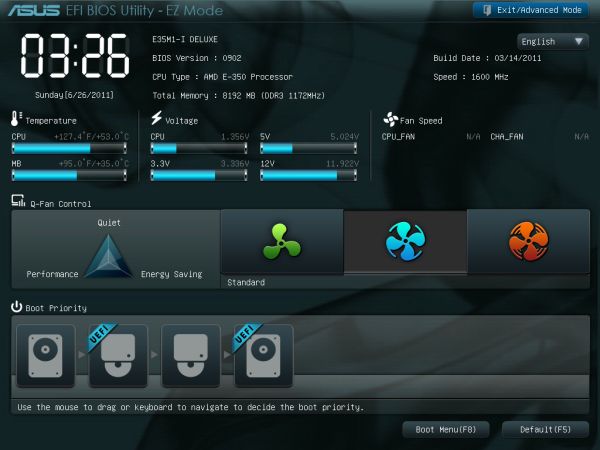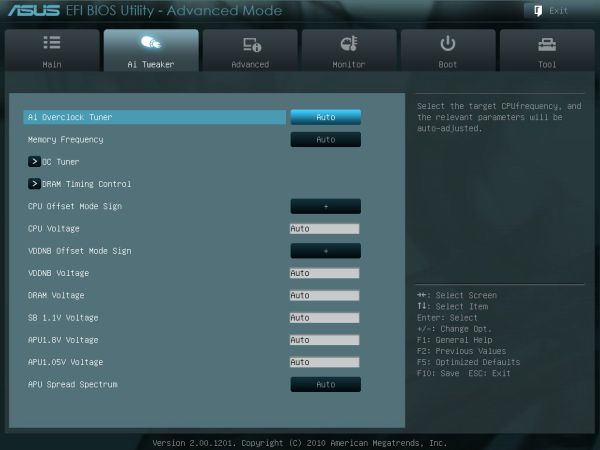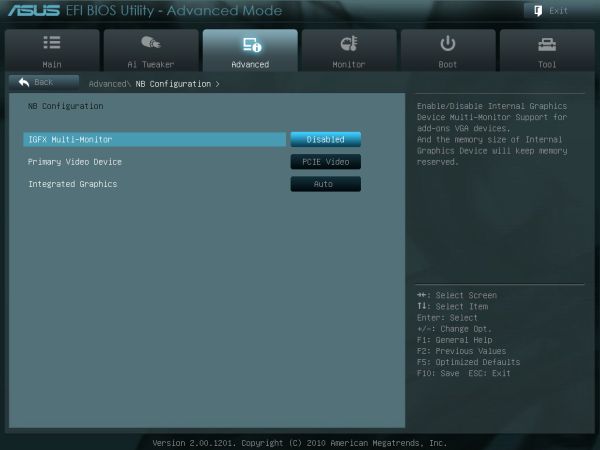Fusion E-350 Review: ASUS E35M1-I Deluxe, ECS HDC-I and Zotac FUSION350-A-E
by Ian Cutress on July 14, 2011 11:00 AM ESTBIOS
The ASUS BIOS solution for Fusion is essentially identical to what we've seen with the Sandy Bridge boards this year - the graphical UEFI implementation, but tailored to the Fusion interface. The front 'EZ mode' (easy, for Brits like me who say 'zed', not 'zee') contains the basic data we want to see - the BIOS version, the CPU, temperatures, voltages, fan speeds, three choices for performance and a quick boot management. This is the cream of UEFI front page implementations, for which ASUS should be applauded. Pressing F12 takes a nice screenshot too.
In advanced mode, 'Ai Tweaker' is where the important action is. First two options are the APU Frequency and Memory Frequency options, followed by OC Tuner (which acts exactly like the Turbo Key switch on the motherboard itself, by applying a default 5% overclock on the next boot) and the memory timing screen.
I actually found a small error in the BIOS here - if you select a manual bus speed overclock, say to 110 MHz, the Memory frequency options change to reflect this 10%, to 880 Mhz and so on. However, if you then decide not to apply the overclock and select 'Auto' on the Ai Overclock Tuner, the Memory Frequency values are stuck at the 10% overclocked values, even if on the next boot they will actually be based off the 100 MHz clock. It's just a small coding error, but odd it wasn't picked up during testing.
Also of interest is the 'NB Configuration' menu. Judging by these options, if you want to run a multi-monitor setup from the integrated GPU (so a HDMI 1.3b and DVI), this option will need to be enabled. However, the help menu mentions VGA devices - whether that explicitly means analog devices or in general video outputs, I'm not sure, but there's no VGA output on this board. So whether it's left over from other boards (the E35M1-M Pro does have a VGA) when they were making this BIOS, again, I'm not sure.
The monitor screen shows us just how hot the CPU is at idle under the passive heatsink - at the time I took this screenshot, we have a CPU running at 52ºC at 1.326 V. In the boot menu, we have the option for a one-off boot device selection, which I think should be a requirement on all future BIOS versions from every vendor.
Just a small after note - the shipping BIOS on the ASUS board is a little unstable. If left alone for a short while, the BIOS will freeze and the only way to fix it is to perform a soft reset. This issue is supposedly fixed with the 0902 BIOS though.
Overclocking
For the ASUS board in this roundup, overclocking was a fraction harder than the ECS. There are two ways to initiate an overclock - from the BIOS/UEFI, or via the Turbo Key II button on the motherboard itself. With the Turbo Key II, we get an instant 5% overclock to take the base speed from 100 MHz to 105 Mhz, and with a 16x multiplier, from 1600 MHz to 1680 MHz. The OC Tuner option in the BIOS has this effect too.
The other alternative is manually adjusting the bus speed from the BIOS. Now as these boards already come with CPUs, the results between boards will be different because of the silicon. With the BIOS, I left the voltage on auto and pushed the bus speed to 110 MHz without issue. At 114 MHz, the board successfully booted but failed the array of 3D iGPU tests in our bench suite. I adjusted it down by 1 MHz until our tests were stable - in the end, only 111 MHz (1776 MHz) was stable enough.
At this level of overclock, the 3D Movement benchmark results were improved by 11.7 % in single threaded mode and 11.0 % in multi threaded. GPU results were considerably different - 21% increase in Metro 2033, 17.3% in Dirt2 and 36% in Left4Dead2, confirming that the CPU or memory is quite the bottleneck in these scenarios.



















67 Comments
View All Comments
andymcca - Friday, July 15, 2011 - link
My bad, missed this on page 11 during my first read-through.tvarad - Friday, July 15, 2011 - link
Ian,I understand your compulsions, but it's like taking a Smart, testing it like a Ferrari and then critiquing it. That's not quite what AMD had in mind on how it intended the board to be used (I own Intel stock, so this is not about taking sides). I have the Asus board and I am using it with a tiny brick that puts out about 47W and powers a Pico-psu 120W 12V-25V wide input range power supply. It's function is as a HTPC/Video Server, hence I have just a 2TB WD HD attached to it, with an external removable media drive. With 2GB Gskill Eco Ram and a 140MM fan, it never goes above 40W when booting up and idles at around 22-23W. With 1080P mkv content play, the consumption goes upto about 30W. I don't plan to overclock it. I'll go out on a limb and say that my rig is more representative of how the board will be used in the real world.
BTW, the square thingies on the pico-psu (at least the model I'm using) jut out onto the second dimm slot rendering it useless. Something you may want to watch out for.
triclops41 - Thursday, July 14, 2011 - link
Easy there, Finally,There are things to criticize about this review on benchmarks chosen or other technical details, but I have not seen any pro atom or anti brazos bias by Ian, or anyone else at Anandtech. Maybe some bias towards synthetic benchmarks, that Intel often wins, but that has more to do with the constraints of hardware reviews, not allegiance to some producer.
Finally - Tuesday, July 26, 2011 - link
Well said. I still really wonder, why there are so many encoding benchmarks here. After all - how many people actually do encode videos? I've never done so my whole life and don't intend starting to. The funny thing is that these are usually the benchmarks where the press is deriving their ridiculous high speed advantages of new Intel CPUs from...If someone came along and said that this "advantage" is completely lost on them, those CPUs wouldn't be that great, because real world game fps are almost always very close to each other...
corporategoon - Thursday, July 14, 2011 - link
I don't really have any comments on the benchmarks or thoroughness or balance of this article (seems fine to me) but this is one of the most poorly-written articles I've ever seen on AnandTech. Anand has a serious problem with sentence fragments but most articles that appear on the site are reasonably well-written. The opening paragraph is borderline unreadable.new-paradigm - Thursday, July 14, 2011 - link
Ok, I may be being dense, but I cant seem to find if any of these boards offer video and sound through the HDMI port?jrs77 - Thursday, July 14, 2011 - link
I've got two miniITX Atom boards. A Zotac IONITX A-E and an ASUS AT3IONT-I Deluxe (both sporting an onboard PSU with a 90Watt powerbrick !!!). Both of them do work like a charm and I'm even capable of playing MMOs (EvE Online) on them in low settings. They draw some 35 Watt from the plug in the wall under load.So why there's no comparison to the Atom-ION boards as they're the direct competition and on the market for a few years now allready?
stmok - Friday, July 15, 2011 - link
While the overall article is OK, it just doesn't have that usefulness of your typical Anandtech article in some areas that make it stand out.For example:
Why did you not include the ECS solution alongside the ASUS one for the overclock part on page 15?
=> http://www.anandtech.com/show/4499/fusion-e350-rev...
What about assessing noise?
=> Sure, you have the two passive mobos, but how loud/quiet was that fan cooled one?
futurepastnow - Friday, July 15, 2011 - link
Looks like the big heatsink ASUS uses is mostly for show since the much smaller one on the Zotac board puts it to shame.beginner99 - Friday, July 15, 2011 - link
... of bobcat. In the forums you can read it having trouble with 1080p sometimes especially flash. Not ideal for a htpc. The GPU part is mostly useless for a HTPC or NAS. Also these mini-ITX boards are pretty expensive and mini-ITX + core i3 doesn't cost much more and would also not use much more power in idle/normal usage but better max. performance for like flash (HTPC) or Software RAID 5 (NAS).Especially for a NAS the price difference is minimal because any small case with lots of HDD bays is pretty expensive.